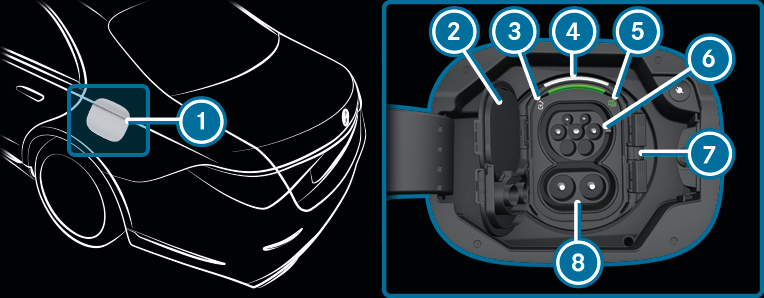The charging process uses high voltage.
If the charging cable, the vehicle socket or the mains socket are damaged, you could receive an electric shock.
During the charging process, the charging cable and charging cable connector can heat up within their permissible limit values.
the power supply system and the charging cable are not damaged
the instructions for handling the charging cable and the control element on the charging cable have been observed
The transmission is in position
 .
. The vehicle is unlocked or the distance between the key and the vehicle does not exceed 1 m.
The hybrid system is not activated. The
 display in the driver display is out.
display in the driver display is out. The charging cable is not taut.
Type 1 for charging with alternating current (mode 2 or 3)
Combo 1 for charging with alternating current (mode 2 or 3) and charging with direct current (mode 4)
Type 2 for charging with alternating current (mode 2 or 3)
Combo 2 for charging with alternating current (mode 2 or 3) and charging with direct current (mode 4)


 and swing open the socket flap.
and swing open the socket flap. The  indicator lamp
indicator lamp  and upper status display
and upper status display  light up white.
light up white.
When the hybrid system is activated (the  display lights up in the driver display), socket flap
display lights up in the driver display), socket flap  cannot be opened.
cannot be opened.
 to the right and fold up socket cover
to the right and fold up socket cover  .
. Vehicles with a vehicle socket combo require only connection  for the charging cable connector. Open only the upper part of socket cover
for the charging cable connector. Open only the upper part of socket cover  .
.
 to the stop. If the wallbox/charging station is not equipped with a charging cable, insert the plug of the vehicle's charging cable into the wallbox/charging station socket to the stop.
to the stop. If the wallbox/charging station is not equipped with a charging cable, insert the plug of the vehicle's charging cable into the wallbox/charging station socket to the stop. Make sure that the charging cable is not taut when inserted.
The  indicator lamp
indicator lamp  and lower status display
and lower status display  flash orange and, as soon as the high-voltage battery is charged, green.
flash orange and, as soon as the high-voltage battery is charged, green.
When the charging sequence for the ambient lighting is activated, the ambient lighting lights up for approximately 30 seconds as with the  indicator lamp
indicator lamp  More.
More.
If the charging cable is connected to the vehicle, the drive system cannot be started and the vehicle cannot be moved.
At the start of the charging process, the charge level display is shown in the driver display with a charging prediction. The charging prediction refers to the time at which the high-voltage battery will be fully charged.
Depending on the temperature, the fan and battery cooling system may audibly switch on during the charging process.
If the vehicle is idle for lengthy periods and connected to the mains supply, the high-voltage battery will be recharged automatically as needed or when electrical consumers are activated (e.g. the pre-entry climate control).
The vehicle is equipped with an electrical fuse which protects it against overvoltage in the mains supply. This electrical fuse may trip during severe thunderstorms, for example, and may cause the fuse in the building to trip or may interrupt the charging process. These functions protect the vehicle.
After the fuse in the building is switched on again, the charging process resumes automatically. Following an interruption in the power supply without the fuse in the building being tripped, it may take up to ten minutes for charging to resume automatically.

